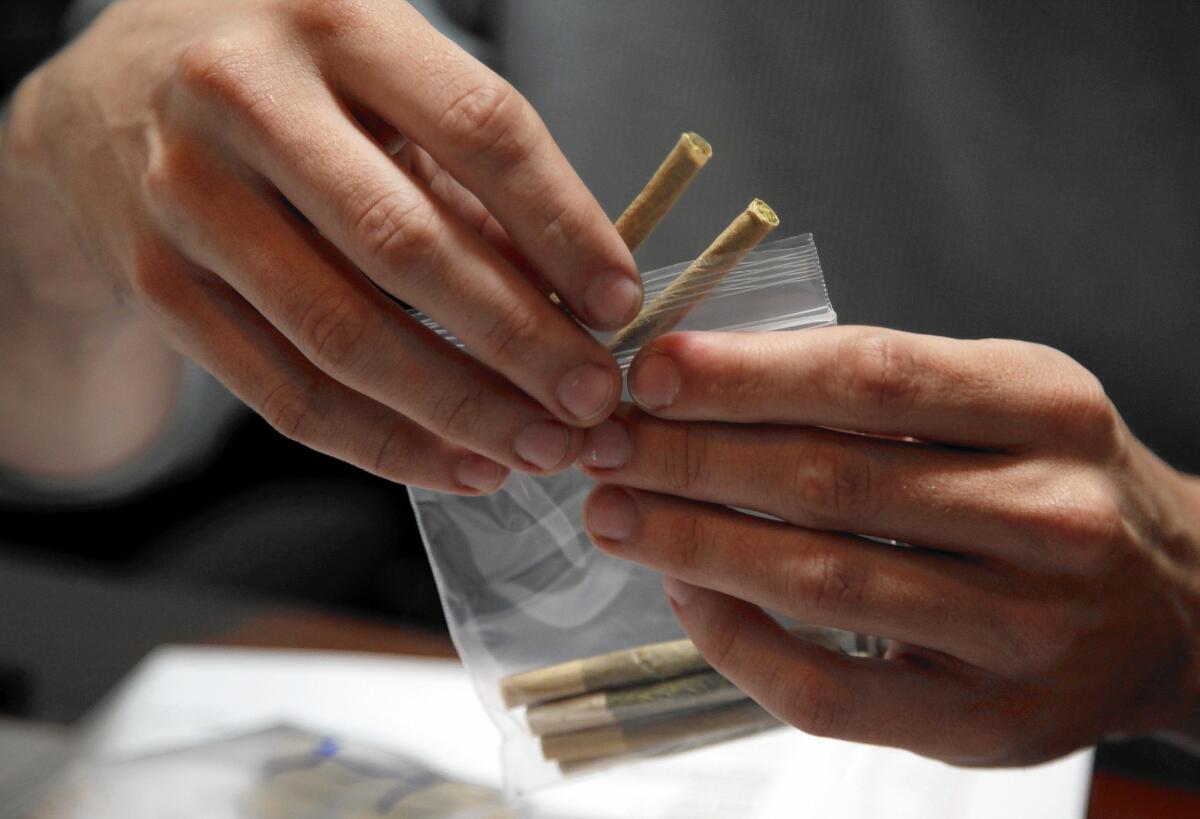Medical marijuana could reduce painkiller abuse, study suggests

- Share via
Could medical marijuana be an antidote for the nation’s scourge of fatal overdoses caused by prescription pain medication? A new study suggests the answer is yes, and it’s set off a flurry of medical debate over the risks and benefits of making cannabis more widely available to patients.
The new research, published Monday in the journal JAMA Internal Medicine, finds that deaths associated with the use of opiate drugs fell in 13 states after they legalized medical marijuana. Compared with states with no formal access to marijuana, those that allowed certain patients legal access to cannabis saw a steady drop in opiate-related overdoses that reached 33%, on average, six years after the states’ medical marijuana laws took effect.
“The striking implication is that medical marijuana laws, when implemented, may represent a promising approach for stemming runaway rates of nonintentional opioid-analgesic-related deaths,” wrote opiate abuse researchers Dr. Mark S. Brown and Marie J. Hayes in a commentary published alongside the study. “If true, this finding upsets the apple cart of conventional wisdom regarding the public health implications of marijuana legalizations and medicinal usefulness.”
That apple cart has already been shaken by a growing body of research that suggests marijuana’s psychoactive ingredients may enhance the pain-killing effects of opiate drugs, allowing patients using marijuana for pain to take lower — and less dangerous — doses of opiate medications.
“It’s so apparent that our patients can decrease, diminish or wean themselves completely off of opiates, and that it improves their quality of life,” said Dr. Donald Abrams, a UC San Francisco oncologist who was not involved with the study.
In a small study published in 2011, Abrams found that cancer patients taking morphine and oxycodone experienced greater pain relief at lower opiate blood concentrations when a vaporized form of marijuana was added to their drug regimen. He has just begun recruiting for a study that will explore whether the same formulation can reduce pain, inflammation and opiate doses in patients with sickle-cell disease.
But those who have opposed expanding access to medical marijuana said they were not persuaded that cannabis — a plant designated by the Drug Enforcement Agency as having “no recognized medicinal use” — is a safer alternative to opioids.
“Clearly the study raised an intriguing hypothesis, but many questions still need to be answered,” the National Institute on Drug Abuse said in a statement released Monday. The analysis “should not be oversimplified,” the statement warned.
Patients in 23 states and the District of Columbia now have the option of seeking a prescription for medical marijuana. (Two of those states, Colorado and Washington, also allow recreational use of the drug.) Chronic pain is thought to be the leading indication for cannabis use.
The study authors, led by the University of Pennsylvania’s Dr. Marcus A. Bachhuber, focused on the years 1999 to 2010. The raw figures collected from states’ death certificates showed that rates of fatal opioid overdoses were higher in the states that had implemented medical marijuana laws than in those that had not.
But the researchers took those raw numbers and adjusted them so that it would be easier to make direct comparisons between the states. For instance, they accounted for the fact that each of the states that legalized medical marijuana during the study period did so on different schedules. In addition, they took into account a wide range of factors known to influence opioid abuse, including state unemployment rates and policies tightening access to prescription painkillers.
The results showed that after a state began to implement a medical marijuana law, the rate of its non-intentional opiate overdose fatalities fell compared with those of states without such laws.
And that comparative decline picked up steam over the first six years after the laws went into effect. On average, the statistical analysis showed, states passing medical marijuana laws saw annual reductions of roughly 25% in their opioid-related death rates compared with states with no such laws.
In their first year after implementation of the laws, the 13 states averaged an opiate-related fatality rate 20% lower than those of states without legalized medical marijuana. The average difference between the two groups of states widened at two and three years out, returned to 20% in year four, then rose to just over 33% in years five and six.
About 60% of the nation’s fatal opioid overdoses occur among patients who have legitimate prescriptions for their medications. The authors wrote that in states where access to medical marijuana is legal, legitimate opioid drug users may take lower doses of that prescription pain medication, making overdose less likely.
Others may use marijuana in place of benzodiazepine drugs — sedatives that make a fatal overdose much more likely. Still other patients who might initiate opioid medication use — and go on to risk overdose — may never start if they are able to get pain relief from medical marijuana, the study authors wrote.
“That connection may be intrinsically appealing — some might view the idea that people could use a milder drug versus an opiate as an improvement,” said Kevin Sabet, director of the University of Florida Drug Policy Institute, in a statement. But the new study suffers from “too many uncertainties” to allow that conclusion, he said.
Dr. Mark Ware, a pain specialist and professor of family medicine at McGill University in Montreal, called the JAMA Internal Medicine study “very interesting, and methodologically robust.” But, he added, “there’s probably a temptation to extend the findings of this study to far broader conclusions than are justified.”
The United States “is conducting a natural experiment” on a national scale, said Ware, who is executive director for the Canadian Consortium for the Investigation of Cannabinoids, an advocate for more research on marijuana’s medical potential.
Before physicians and government officials can draw conclusions on the public health benefits of medical marijuana laws, he said, they need more detailed studies of how medical marijuana users take the drug and how its use affects physicians’ prescribing decisions, especially for patients with chronic pain.
Twitter: @LATMelissaHealy
More to Read
Sign up for Essential California
The most important California stories and recommendations in your inbox every morning.
You may occasionally receive promotional content from the Los Angeles Times.











